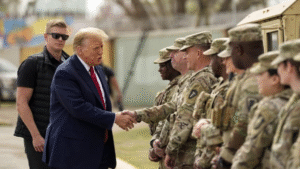The Deployment Directive: Trump’s Marines and the Battle Over Power
In the final days of summer 2025, President Donald Trump issued a sweeping directive: deploy thousands of U.S. Marines and National Guard troops to multiple domestic and international locations. The announcement, made during a press briefing at the White House, was blunt, theatrical, and unmistakably Trumpian. “We’re going to clean up the mess,” he said. “Whether it’s in our cities or on our doorstep.”
The deployments were framed as part of a broader campaign to combat crime, suppress unrest, and apply “maximum pressure” to foreign adversaries. But beneath the surface, the moves revealed a deeper tension—between executive authority and constitutional limits, between domestic order and militarized control, and between America’s role abroad and its reckoning at home.
🧭 Marines in Los Angeles: The Domestic Flashpoint
One of the most controversial deployments occurred in Los Angeles, where Trump sent active-duty Marines and National Guard troops in June to assist law enforcement during protests against immigration enforcement raids. The protests were largely peaceful, but the administration claimed they posed a threat to public safety.
The optics were stark: armored vehicles rolling through city streets, uniformed Marines setting up perimeters, and federal agents conducting crowd control. Critics called it political theater. Supporters called it decisive leadership.
But on September 2, a federal judge ruled that Trump’s deployment violated the Posse Comitatus Act—a law dating back to 1878 that prohibits the use of the military for domestic law enforcement. Judge Charles Breyer’s ruling was scathing: “No president is a king—not even Trump—and no president can trample a state’s power to protect its people.”
California Governor Gavin Newsom, who had sued the administration, declared victory. “Trump’s use of the military as his personal police force is illegal, authoritarian, and must be stopped in every courtroom across this country,” he said.
The ruling barred Marines and National Guard troops from performing arrests, searches, or crowd control in California. But the administration appealed immediately, setting the stage for a constitutional showdown.
🔥 Marines in the Caribbean: The Venezuela Gambit
While legal battles raged at home, Trump expanded military operations abroad. In early September, the Pentagon confirmed that three amphibious assault ships—carrying more than 4,000 sailors and Marines—were entering the Caribbean region. Their destination: waters near Venezuela.
The deployment followed Trump’s authorization to use military force against Latin American drug cartels. But many saw it as a veiled threat against Venezuelan President Nicolás Maduro, whom Trump has long sought to remove from power.
Maduro responded with fury. “The United States is pointing 1,200 missiles at our country,” he said during a press conference in Caracas. “We are prepared to constitutionally declare a republic in arms should the U.S. attack.”
The rhetoric was chilling. The U.S. Navy already had multiple warships in the region, including Aegis guided-missile destroyers and cruisers. Now, with Marines entering the theater, the threat of escalation loomed large.
An anonymous Defense Department official told reporters, “The president has asked for a menu of options… Maduro should be shitting bricks.”
🏙️ Marines in New Orleans: The Crime Crackdown
Back in the U.S., Trump suggested he might deploy Marines to New Orleans next. “We’ll straighten that out in about two weeks,” he said, citing rising crime rates. Louisiana Governor Jeff Landry welcomed the idea. “We will take President Trump’s help from New Orleans to Shreveport,” he posted on social media.
But local leaders pushed back. Representative Troy Carter, whose district includes New Orleans, called the move “militarizing the streets” and said it was not a solution. “If the President wants to help, fund programs that address systemic poverty,” he said.
City data showed that crime in New Orleans was actually down 21.5% compared to the previous year. The mayor’s office emphasized ongoing collaboration with federal agencies and questioned the need for military intervention.
Still, Trump remained undeterred. “We’ll solve the crime problem fast,” he said. “Just like we did in D.C.”
🧠 The Constitutional Collision
The deployments have reignited debates about presidential power. Can a president use the military to police American cities? Can he bypass governors and local officials? Can he deploy Marines without congressional approval?
Legal scholars point to the Posse Comitatus Act and the Insurrection Act—laws that limit and define the use of military force on U.S. soil. Judge Breyer’s ruling in California was a clear rebuke. But Trump’s appeal, and the possibility of a Supreme Court review, means the issue is far from settled.
Critics warn that Trump is testing the boundaries of executive authority. “He appears intent on creating a national police force with the President as its chief,” Breyer wrote.
Supporters argue that Trump is fulfilling his mandate to “Make America Safe Again.” They see the deployments as necessary responses to lawlessness, drug trafficking, and urban decay.
The truth may lie somewhere in between. But the stakes are high.
💡 What We Learn
From Trump’s deployment of U.S. Marines, we learn that power is performative. That military might can be used as both shield and spectacle. That the line between protection and provocation is razor-thin.
We learn that cities are not just battlegrounds—they’re symbols. That Los Angeles, New Orleans, and Caracas are not just locations—they’re stages for a global drama.
We learn that the Constitution is not a relic—it’s a referee. That laws like the Posse Comitatus Act still matter. That judges still have the power to say no.
And we learn that in 2025, the role of the military in American life is being redefined—by politics, by fear, and by the man in the Oval Office.


